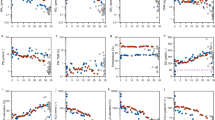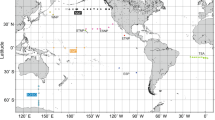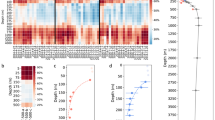Abstract
IT has been suggested that denitrification in continental shelf and slope sediments is the most important sink in the marine nitrogen cycle1–4. This conclusion has been reached, not from direct measurements of denitrification in these areas, but rather from indirect estimates derived from pore-water models of diagenetic processes. In highly bioturbated continental shelf and slope sediments with steep pore-water gradients, such indirect estimates may not be applicable5,6.1 have now made direct, in situ measurements of denitrification in sediments of the eastern North Pacific continental margin by determining the flux of molecular nitrogen out of the sediments into the overlying water. Denitrification rates in continental shelf sediments measured in this fashion averaged 3.7 pmol N cm−2s−1. The flux of nitrate from the overlying water into the sediments was only 1.5 pmol N cm−2s−1, showing that most of the nitrogen gas production is coupled to nitrification within the sediments. The denitrification rates observed here are four to five times those estimated previously by indirect methods for these same sediments, and indicate the limitations of such indirect estimates. My results suggest that the global denitrification rate in shelf and slope sediments may be greater than previously thought, and confirm the importance of sedimentary denitrification in the marine nitrogen budget.
This is a preview of subscription content, access via your institution
Access options
Subscribe to this journal
Receive 51 print issues and online access
$199.00 per year
only $3.90 per issue
Buy this article
- Purchase on Springer Link
- Instant access to full article PDF
Prices may be subject to local taxes which are calculated during checkout
Similar content being viewed by others
References
Codispoti, L. A. & Christensen, J. P. Mar. Chem. 16, 277–300 (1985).
Codispoti, L. A. in Production of the Oceans (eds Berger, W. H., Smetaceck, V. S. & Wefer, G.) 337–394 (Wiley, New York, 1989).
Christensen, J. P., Murray, J. W., Devol, A. H. & Codispoti, L. A. Global biogeochem. Cycles 1, 87–116 (1987).
Bender, M. L. et al. Geochim. cosmochim. Acta. 53, 685–698 (1989).
Devol, A. H. Deep Sea Res. 34, 1007–1026 (1987).
Berelson, W. M., Hammond, D. E. & Johnson, K. S. Geochim. cosmochim. Acta 51, 1345–1363.
Hattori, A. in Nitrogen in the Marine Environment (eds Carpenter, E. J. & Capone, O. G.) 191–232 (Academic, New York, 1983).
Devol, A. H. Deep Sea Res. 25, 137–146 (1978).
Naqvi, T. J. mar. Res. 45, 1049–1072 (1987).
Billen, G. Am. J. Sci. 282, 512–541 (1982).
Jahnke, R. A., Emerson, S. R. & Murray, J. W. Limnol. Oceanogr. 27, 610–623 (1982).
Christensen, J. P., Smethie, W. M. & Devol, A. H. Deep Sea Res. 34, 1027–1047 (1987).
Berner, R. A. Early Diagenesis (Princeton University Press, 1980).
Aller, R. C. et al. Cont. Shelf Res. 4, 227–251 (1985).
Carpenter, R., Bennett, H. T. & Peterson, M. L. Geochim. cosmochim. Acta 45, 1155–1172 (1981).
Carpenter, R. Deep Sea Res. 34, 881–896 (1987).
Archer, D. & Devol, A. H. Limnol. Oceanogr. (in the press).
Noshoi, T., Koike, J. & Hattori, A. Appl. Envir. Microbiol. 26, 409–415 (1979).
Seitzinger, S. P., Nixon, S. W. & Pilson, M. E. Q. Limnol. Oceanogr. 29, 73–83 (1984).
Sorensen, J. Appl. envir. Microbiol. 35, 301–305 (1978).
Jenkens, M. C. & Kemp, W. M. Limnol. Oceanogr. 29, 609–619 (1984).
Seitzinger, S. P. Limnol. Oceanogr. 33, 702–724 (1988).
Archer, D., Emerson, S. & Smith, C. J. Nature 340, 623–626 (1989).
Christensen, J. P. & Rowe, G. T. J. mar. Res. 42, 1099–1116 (1984).
Gardner, W. S., Nalepa, T. F. & Malczyk, J. M. Limnol. Oceanogr. 32, 1226–1238 (1987).
Emerson, S. R. et al. Earth planet. Sci. Lett 61, 220–232 (1980).
Froelich, P. N. et al. Geochim. cosmochim. Acta 43, 1075–1090 (1979).
Shaffer, G. & Ronner, U. Deep Sea Res. 31, 197–202 (1984).
Parsons, T. R., Maita, Y. & Lalli, C. M. A Manual of Chemical and Biological Methods of Seawater Analysis (Pergamon, New York, 1984).
Kuivila, K. M. thesis (University of Washington, Seattle, 1986).
Author information
Authors and Affiliations
Rights and permissions
About this article
Cite this article
Devol, A. Direct measurement of nitrogen gas fluxes from continental shelf sediments. Nature 349, 319–321 (1991). https://doi.org/10.1038/349319a0
Received:
Accepted:
Issue Date:
DOI: https://doi.org/10.1038/349319a0
This article is cited by
-
Coupling of oceanic carbon and nitrogen facilitates spatially resolved quantitative reconstruction of nitrate inventories
Nature Communications (2018)
-
Nitrogen-15 Isotope Enrichment in Benthic Boundary Layer Gases of a Stratified Eutrophic Iron and Manganese Rich Lake
Aquatic Geochemistry (2012)
-
Dynamics of Nitrous Oxide Reductase Genes (nosZ) in Intertidal Rocky Biofilms and Sediments of the Douro River Estuary (Portugal), and their Relation to N-biogeochemistry
Microbial Ecology (2008)
-
Denitrification pathways and rates in the sandy sediments of the Georgia continental shelf, USA
Geochemical Transactions (2005)
Comments
By submitting a comment you agree to abide by our Terms and Community Guidelines. If you find something abusive or that does not comply with our terms or guidelines please flag it as inappropriate.



